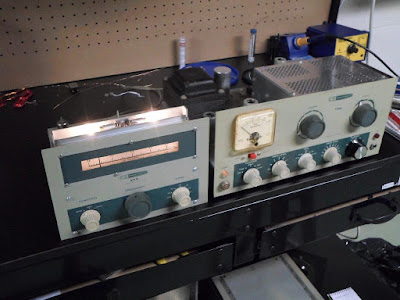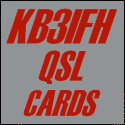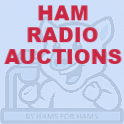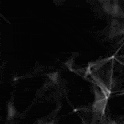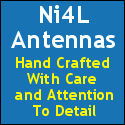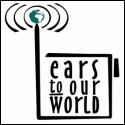Posts Tagged ‘Nostalgia’
 Taking things for granted
Taking things for granted
Before I start this post, I want to dispel any rumors that all W2LJ does at Field Day is take photographs. Here are two of yours truly actually pounding brass and adding points to the NJ2SP Field Day total - courtesy of Mario KD2HPF.
 |
Field Day, or perhaps better said, the end of Field Day often causes me to wax nostalgic. That definitely happened this year, and a large part of it was seen in that video which I posted yesterday. Watching Marv K2VHW working ZL4TT in New Zealand brought back me back, in an instant, to something that happened to me, as a newly licensed Amateur Radio operator so many years ago.
A little context - Bill W2AOF, our Club President, spent a month with friends in New Zealand earlier this year. When he got back, he filled us in on the details of the trip. He had a great time, got to see a lot of wonderful sights, got to eat good food and spend quality time with good people. Yet, there was a price to pay, and I'm not referring to the monetary expense. Sure, there was that, but there was also an expenditure of time.
With all the technological advancements we've witnessed over the last century, getting to New Zealand from New Jersey is comparatively easy compared to 100 years ago. Back then, the ocean voyage took weeks. Flying by air is a snap compared to that, but even that takes time. You don't often think about it, but even flying on a commercial aircraft, going at speeds never dreamt of by the seafaring ships of the old days, it still takes the better part of a day (around 18 hours) to get from New Jersey to New Zealand. And in the middle of the overnight, in the wee hours of Sunday morning, with 5 Watts of power to a hunk of wire hanging in the air, we made that trip and back in seconds, the whole conversation taking a few minutes!
I was struck by that, once again. I wish Bill had been there. He had left a few hours earlier to make sure the A/C was working properly in his home as well as to get some much needed rest. Had he been there. Bill is the kind of guy who would have been taken aback and would have experienced that "Wow factor" of what had just been accomplished. We communicate with all parts of the world. There is really no place too far that our radio waves can't reach. But how often do we let that soak in? How often do we get annoyed when that DX contact isn't made. How often do we take our radios and our hobby and all the physics involved for granted?
I guess I'm one of the lucky ones, as I had a similar experience happen to me back in 1979, and I'm sure it's been related somewhere earlier in this blog. But I like to think about it, it's an enjoyable memory and I'll re-tell it again.
I passed my Novice exam sometime back in October/November of 1978. The actual paper "ticket" came in the mail the last week of the year. I didn't even get on the air until the end of January of 1979, as I was busy putting my station together, and building my Heathkit Novice receiver kit that I had gotten as a Christmas gift. I upgraded to General in July and I worked my first DX contact with a Ham in Germany shortly thereafter.
Later that year in October of 1979, my best friend and I decided to take a trip up to the White Mountains in New Hampshire to do some photography. We were two young budding photographers who were working together at a local camera shop and we both needed a road trip. We got our much needed time off and eventually made it all the way to Maine, specifically Bar Harbor. From there we decided that we would follow the coast as we made our way back to New Jersey.
That meant a side trip to Cape Cod, and on the way out to Provincetown for some authentic New England clam chowder we came across a sign indicating that we were approaching the site of Marconi's Wellfleet Station. I had to stop. We were in my car and I was the driver, so what I say goes .....goes. Right? What newly minted Amateur Radio operator would not want to visit a Marconi site?
Not my image, but this is what you see when you visit. ^ This site is part of the National Park's Cape Cod National Seashore entity, so it is well maintained and there is a plethora of history to read about. This is what it looked like back in the day:
A few of the cement pylons that anchored the legs of the antenna towers were still there when I visited. Most had washed away into the sea as a result of beach erosion.
But it was the sea that struck me the most, which is a strange thing to say as I was born, bred and continue to live in New Jersey. I've seen the Atlantic Ocean and it bays hundreds, if not close to a thousand times in my time here on earth. But that time was different.
I had not yet traveled to Switzerland, and would not experience air travel to Europe for another nine years, but standing there, for a VERY long time, where history had been made, just staring at the ocean, looking out upon all that water as far as my eye could see, was an experience unlike any other I had ever had. All I could think of was the radio waves from my Drake 2-NT and my MorGain multiband dipole, flying over all that water to another Ham in Germany. And her radio waves (she was an XYL) travelling back to my Heathkit HR-1680 receiver in a matter of seconds.
That water looked like it would never end. I knew that it did. I knew that on the other side of that vastness was Europe and the rest of the world. To contemplate my radio signals covering all that distance made me feel so tiny, but also filled me with awe at the immensity of Creation at the same time.
We get so busy on Field Day and the rest of the year with making contacts, conducting ragchews, running nets, competing in contests, speaking into microphones, banging away on keys, typing away on keyboards that we forget to notice what is really happening. It's the magical part of Amateur Radio that never grows old for me and I hope I never take it for granted.
Long winded, I know, but thanks for staying with me!
72 de Larry W2LJ
QRP - When you care to send the very least!
 It’s ‘Bug Roundup’ Weekend!
It’s ‘Bug Roundup’ Weekend!
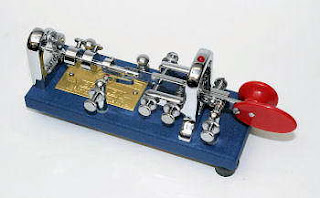 |
| Vibroplex "Blue Racer" |
Ever since earning my ticket as a teenager back in '63, almost all of my on-air activity has been focused on CW ... I've always loved it.
Back when I first got on the air there were very few amateurs using keyers. Most used bugs and the remainder used hand keys. It was very easy to tune across the band and identify any of the locals just by the sound of their fist ... like snowflakes, no two were the same. The same went for most stations that were very active. DX or otherwise, one could usually tell who it was, long before the callsigns were sent.
So much has changed now with the almost exclusive use of electronic keyers and everyone pretty much sounds the same, which is rather unfortunate I think.
Once my interest in building vintage-style vacuum-tube transmitters evolved, my interest in bugs was reactivated and over the years I have purchased a few more.
I'll do everything I can to promote and encourage the use of CW and especially hand-generated CW. That's why I was excited, once again, to read a recent e-mail from W6SFM, posted to several lists that I read, announcing the Bug Roundup!
The Samuel F. Morse Amateur Radio Club, a Sacramento, California based CW enthusiast club wanted a special time to bring bug operators together on the air. In the same spirit as ARRL's Straight Key Night, participants are encouraged to make simple, conversational, “chewing-the-fat” QSOs using their bug type key. This is an opportunity to exercise, share and exhibit your personalized fist. This is NOT a contest.
However, there is a very easy and quick required signup form found at https://w6sfm.com/bug-roundup/.
Once you are registered for the event simply call "CQ BR" so folks know you are a Bug Roundup Participant. So lets grab that bug, clean those contacts, and let’er fly! We want to hear that “Banana Boat / Lake Erie Swing" or that commercial KPH/WCC quality fist.
Reserve the date! The event begins on Friday November 17th (00:00 UTC) and concludes Sunday Nov. 19th (23:59 UTC), 2017.
That's 4:00 PM Friday evening until 3:59 PM Pacific Time (LOCAL)
For more information, to register your station, and to help assist in spotting, potentially increasing QSOs, an On-line chat window link can be found near the bottom of Bug Roundup home page located at https://w6sfm.com/bug-roundup/ We hope to hear you all on the air! 73, W6SFM
 |
| courtesy: arrl.org |
 The Green Glow
The Green Glow

Recent emails from two friends brought new insight into a blog that I had been intending to do for some time.
As has been mentioned on more than one occasion, I discovered radio at the age of 10, after reading an article about shortwave-listening in a drugstore magazine. My father was able to rescue an old GE cathedral from grandpa's downtown barbershop, where it sat gathering dust for several years in the back room storage space. Fortunately, it immediately came to life when plugged in and soon after dad spent an afternoon scurrying about on the roof of our 3-story house in central Vancouver, my radio-adventures began.
As I recall, the first couple of weeks were spent listening to radiotelephone traffic between various tugboats and their dispatchers, in the 2 megacycle marine band. Initially it took me awhile to figure out what I was listening to but found it fascinating to hear the tugboats up and down the coast getting their daily marching orders.
It wasn't too much later that I discovered the international shortwave bands and I was soon keeping detailed logs of my catches and mailing for a coveted QSL. Friday nights were always special as it meant I could DX well into the night and not worry about having to get out of bed for school early the next morning. My 3rd floor bedroom shack was the true definition of 'warm and cozy' and a memory I will always cherish.
Up to this point I had yet to discover ham radio. I must have tuned across a few conversations on phone but evidently hadn't been too awestruck at what I had heard ... perhaps I didn't know what I was hearing or was unable to comprehend some of the expressions they were using or what they were talking about when describing their gear. For whatever reason, the ham radio 'trigger-event' had not yet transpired ... but it soon would.
By this time, I had moved upward, from the Boy Cubs to the Boy Scouts. I must explain that these activities were forced upon me by my parents and not something I particularly enjoyed, especially the midwinter camping trips that were always pouring rain or freezing. Again, from grandfather, I had been provided with an old, virtually uninsulated, WW1 sleeping bag, that wouldn't have kept anyone alive at the western front for longer than a week. These all too regular winter excursions to the rain forest were pure misery and if I wasn't freezing to death then my sleeping bag was usually getting soaked from the river of rain running through the tent ... most of these weekend outings were sleepless and left me feeling like a zombie for the next few days. But ... not every scouting experience was bad and in fact, it was a scouting event that would soon provide my ham-radio 'trigger'!
The opportunity arrived for those that wished, to visit a local 'ham station' to partake in some sort of 'on-the-air experience'. This would have been in 1958 and having been already familiar with shortwave radio, I immediately signed-on.
A few weeks later, about six of us found ourselves in the basement shack of Ernie Savage, VE7FB. Although a stranger to me, Ernie was a well known 75m phone traffic man and an ardent 75m mobile operator. Although he was only about five-foot two, Ernie was a powerhouse of a personality and most of us cowered quietly as Ernie tweaked the dials and with a tight grip on his large microphone, barked louder than his small stature might suggest ... all of us quietly prayed that Ernie wouldn't pass the microphone to any of us.
And then I saw it! Although I didn't know it at the time, it was a pivotal moment in my development and would shape all aspects of my life from that point forward.
| courtesy: Paul's Tube Radio Restorations |
 |
| Heathkit VF-1 VFO Dial |
Perhaps the Heathkit engineers had learned of the 'power of green' from those earlier genius Hallicrafter's draftsmen ... can anyone deny the alluring appeal of a Hallicrafter's front panel or dial?
 |
| Hallicrafters SX-42 Dial |
As a young teen, I could never afford to buy a DX-100 but I was able to buy a VF-1 and added one to my Heathkit DX-20 magic transporter. With the lights turned off in the high attic bedroom shack, the orange dials of the Super Pro and its backlit S-meter combined with the seductive green glow of the VF-1. It just couldn't get any better!
Until recently, I had no real idea of why I had found the green dials so enchanting but an email from Mark, VA7MM, finally made it all perfectly clear. Mark offered the most plausible explanation ... the diabolical Heathkit and Hallicrafters engineers had been putting Kryptonite in their dials ... the stuff that even Superman found overpowering and unable to resist!
 |
| Powerless |
 The Green Glow
The Green Glow

Recent emails from two friends brought new insight into a blog that I had been intending to do for some time.
As has been mentioned on more than one occasion, I discovered radio at the age of 10, after reading an article about shortwave-listening in a drugstore magazine. My father was able to rescue an old GE cathedral from grandpa's downtown barbershop, where it sat gathering dust for several years in the back room storage space. Fortunately, it immediately came to life when plugged in and soon after dad spent an afternoon scurrying about on the roof of our 3-story house in central Vancouver, my radio-adventures began.
As I recall, the first couple of weeks were spent listening to radiotelephone traffic between various tugboats and their dispatchers, in the 2 megacycle marine band. Initially it took me awhile to figure out what I was listening to but found it fascinating to hear the tugboats up and down the coast getting their daily marching orders.
It wasn't too much later that I discovered the international shortwave bands and I was soon keeping detailed logs of my catches and mailing for a coveted QSL. Friday nights were always special as it meant I could DX well into the night and not worry about having to get out of bed for school early the next morning. My 3rd floor bedroom shack was the true definition of 'warm and cozy' and a memory I will always cherish.
Up to this point I had yet to discover ham radio. I must have tuned across a few conversations on phone but evidently hadn't been too awestruck at what I had heard ... perhaps I didn't know what I was hearing or was unable to comprehend some of the expressions they were using or what they were talking about when describing their gear. For whatever reason, the ham radio 'trigger-event' had not yet transpired ... but it soon would.
By this time, I had moved upward, from the Boy Cubs to the Boy Scouts. I must explain that these activities were forced upon me by my parents and not something I particularly enjoyed, especially the midwinter camping trips that were always pouring rain or freezing. Again, from grandfather, I had been provided with an old, virtually uninsulated, WW1 sleeping bag, that wouldn't have kept anyone alive at the western front for longer than a week. These all too regular winter excursions to the rain forest were pure misery and if I wasn't freezing to death then my sleeping bag was usually getting soaked from the river of rain running through the tent ... most of these weekend outings were sleepless and left me feeling like a zombie for the next few days. But ... not every scouting experience was bad and in fact, it was a scouting event that would soon provide my ham-radio 'trigger'!
The opportunity arrived for those that wished, to visit a local 'ham station' to partake in some sort of 'on-the-air experience'. This would have been in 1958 and having been already familiar with shortwave radio, I immediately signed-on.
A few weeks later, about six of us found ourselves in the basement shack of Ernie Savage, VE7FB. Although a stranger to me, Ernie was a well known 75m phone traffic man and an ardent 75m mobile operator. Although he was only about five-foot two, Ernie was a powerhouse of a personality and most of us cowered quietly as Ernie tweaked the dials and with a tight grip on his large microphone, barked louder than his small stature might suggest ... all of us quietly prayed that Ernie wouldn't pass the microphone to any of us.
And then I saw it! Although I didn't know it at the time, it was a pivotal moment in my development and would shape all aspects of my life from that point forward.
| courtesy: Paul's Tube Radio Restorations |
 |
| Heathkit VF-1 VFO Dial |
Perhaps the Heathkit engineers had learned of the 'power of green' from those earlier genius Hallicrafter's draftsmen ... can anyone deny the alluring appeal of a Hallicrafter's front panel or dial?
 |
| Hallicrafters SX-42 Dial |
As a young teen, I could never afford to buy a DX-100 but I was able to buy a VF-1 and added one to my Heathkit DX-20 magic transporter. With the lights turned off in the high attic bedroom shack, the orange dials of the Super Pro and its backlit S-meter combined with the seductive green glow of the VF-1. It just couldn't get any better!
Until recently, I had no real idea of why I had found the green dials so enchanting but an email from Mark, VA7MM, finally made it all perfectly clear. Mark offered the most plausible explanation ... the diabolical Heathkit and Hallicrafters engineers had been putting Kryptonite in their dials ... the stuff that even Superman found overpowering and unable to resist!
 |
| Powerless |
 Nasty OT Ham – Reality or Myth?
Nasty OT Ham – Reality or Myth?
It's not uncommon for me to read the articles, and then inevitably, come across some comment by a self-proclaimed "newbie" wherein he or she begins to bemoan the treatment they've received from some "old fart", nasty, mean ol' Ham.
The common scenario seems to be:
"I'm new, bright-eyed, bushy tailed, full of exuberance and spit and vinegar - but yet somewhat lacking in knowledge and experience. I've gone to WB#XYZ repeater or to the Amateur Radio Club of Greater Podunk, where my inquiries were met with laughter, ridicule, sarcasm and down right meanness from Joe Ham. I am now going to sell all my Amateur Radio equipment because I'm traumatized and I never even want to hear the words "Amateur Radio" again."
I've seen this retold several times, in several different instances. I hate to question the veracity of the people making these claims - but can they be true? This has become a pet peeve of mine.
I've mentioned many times now, that I've been licensed for over 35 years. In all that time, I have never, ever, not even once come across treatment like that from an older Ham. Don't get me wrong, I've had to withstand my share of newbie ribbing, and have received my share of friendly and gentle reprimanding when doing something wrong - but nothing like these guys are describing.
A case in point. Shortly after upgrading to General in 1979, I joined the Old Bridge Amateur Radio Association. They owned and operated the KB2TX repeater at the time (well actually, it became the KB2TX repeater after Walt, the owner, changed his callsign to KB2TX - I forget what it was before that). Anyway, I had installed a used non-Icom microphone with a DTMF pad on my Icom 2 Meter mobile, so that I could make phone patches if the need came up. Back in those days, (am I dating myself?) it was rare for a mobile microphone to come with a keypad pre-installed. Unbeknownst to me, the microphone's element wasn't working. The DTMF tones were making it through, but my voice wasn't. So Walt got on the air and in his usual gruff and no-nosense manner announced, "Hey! Whoever's sending the tones - you've got no audio. Stop it and identify yourself". I was saying "KA2DOH (my call at the time) testing.", but it wasn't coming through. I had Walt's phone number and gave him a call, explaining the problem. After listening to my profuse apology, he got quiet and thought for a few seconds. Instead of giving me a tongue lashing, as technically I was breaking the rules, he suggested that the impedance of the microphone element might not be the proper valuthat the rig was looking for - a mismatch. Sure enough, that's what it turned out to be.
I listened and I learned something (that had never occurred to me) and was able to remedy the situation by going to Radio Shack, where I purchased and soldered into my microphone an element with the proper impedance. Walt could have dressed me down, and read me the riot act, but he didn't. He was that way to everybody. In fact, in dealing with all the Old Timers throughout my Amateur Radio career (there were many) - they were all like that. I can't ever remember a time where I received a snotty, snarky or sarcastic reply to a question. In fact, in my dealing with experienced Hams, they have always been helpful, accommodating and educational. And I live in New Jersey, too - supposedly the home of unfriendly, sarcastic, snarky and just plain mean ol' human beings in general!
So where does this curmudgeon live? DOES this curmudgeon live? Or have we become so hyper-sensitive to any kind of criticism that even helpful criticism is taken as an incidence of ego-shattering reprimand?
Maybe they do exist, and maybe I'm lucky that I've never come across one. Maybe I just need to go down on bended knee and be grateful that I've never run across the "No kids, no lids, no space cadets" type of Ham. I can tell you that I have become dear friends with several "Old Timer" Hams who did have very rough and gruff reputations, only to find out after spending some time talking with and listening to them, that they had hearts of pure gold. Sometimes that's all it takes, just listening for a bit instead of always chattering and insisting that we know everything, and that we're always right - when maybe, just perhaps, we're not.
Food for thought.
72 de Larry W2LJ
QRP - When you care to send the very least!
 Still M.I.A.
Still M.I.A.
Of course, it's kind of ironic that one of the two QSL cards that I need would be from the state that I live in - and that my original QSL request was sent to a town just two over from home. I guess I will have to re-send QSL requests to both New Jersey and Delaware. However, instead of mailing the NJ one, I might just drop it off at the manager's mail box. He lives not far off the route I take to get back and forth from work every day. That way I'd be 1000% sure that he received it.
I've been e-mailing back and forth with my good friend Bob W3BBO. At a recent hamfest, he picked up these:
Yes, this is a Heathkit DX-60 and the accompanying HG-10 VFO. Well actually, he picked up the DX-60 at the hamfest. A friend supplied the HG-10 and advised Bob that it needed some TLC, and that if he could get it working, that he could purchase it at a super reasonable price. Bob has succeeded in getting it to work and he e-mailed me this morning that he is in the process of homebrewing a cable to get the output of the VFO into the DX-60.
That reminded me of a much earlier time, when I had these in my Novice station.
My Novice transmitter was a Drake 2-NT that I had purchased through Burghardt Electronics. I had purchased the Globe V-10 VFO from John Kakstys W2FNT who lived in Linden, NJ which was not too terribly far from East Brunswick, where I was living at the time. My receiver was the Heathkit HR-1680, which was my very first Heathkit build. That it worked without a hitch the very first time, upon firing it up, still amazes me to this day.
Anyway, I had the transmitter and I had the VFO. What do I do with them? That was the quandary for me at the time. This was 1979, after all. There was no Internet, no Google. I had no Elmer with whom I could speak, other than the instructor who taught the license class I had attended (and I never got his home telephone number). So it was either get the information I needed from a book, QST or go with my gut and improvise.
I improvised. There was a two conductor cable coming from the output of the VFO. The 2-NT's crystal socket had two holes for where you would plug in a crystal. I figured that the output from the VFO had to go there - it just seemed reasonable to me. So I took a junk crystal, pried the bottom part off, which left me with a base and pins. Then I soldered the two wires coming from the VFO output to the crystal base pins. I plugged it in, hoping the 2-NT wouldn't know the difference between a crystal and a VFO. I took a deep breath, muttered a prayer and turned everything on. I half expected it to blow up, taking me along with it, or to somehow electrocute me.
It didn't.
I connected the 2-NT to a dummy load and adjusted it for the lowest output power I could (see, QRP even way back then, I just didn't know it yet!). Then I turned on the HR-1680 and keyed the 2-NT to see if I could hear anything.
It worked!
I had successfully hooked up my VFO to my transmitter and did not harm myself or anyone else in the process. Much to my parent's delight, I didn't burn down the house, either! I used that setup for a lot of QSOs and enjoyed the heck out of it. After I upgraded to General and bought some equipment capable of doing SSB (silly boy), instead of selling off my Novice station, I donated it to the Handi-Hams, who were pretty much a new organization back then. I guess they must have been desperate for equipment donations at the time, as they gratefully accepted it - homebrewed VFO cable patch job and all.
72 de Larry W2LJ
QRP - When you care to send the very least!
 100 years ago
100 years ago
Last night, I received an e-mail from Bob W3BBO about an item he saw in The County Hunter News. The article was written by Bob Voss N4CD, and it concerned a book written 100 years ago, entitled “Bert Wilson, Wireless Operator“. The book has been made available through Project Gutenberg.






